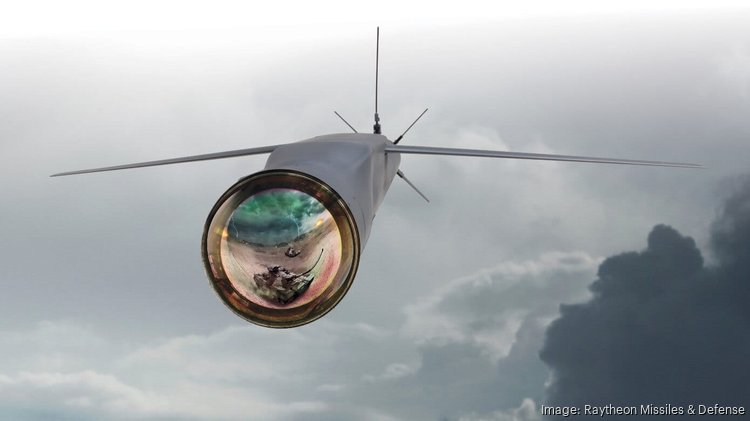Raytheon nabs more advanced weapon contracts, including one with Northrop Grumman

A collaboration between Arizona defense manufacturing giants Raytheon Missiles and Defense and Northrop Grumman will develop a vital system for a new precision missile after the U.S. Army gave the two companies a $97.7 million contract.
That contract, announced this week, comes shortly after Raytheon (NYSE: RTX) said it was awarded a $320.3 million contract to produce a next-generation smart weapon — called the StormBreaker — that will be able to operate in severe weather conditions.
Raytheon’s Missiles and Defense division is based in Tucson, and Northrop Grumman has a significant operation in Chandler and last year expanded its office there.
Precision strike missile details
The precision strike missile (or PrSM) project, which is part of the Army’s Long Range Maneuverable Fires program, calls on Raytheon and Northrop Grumman (NYSE: NOC) to design, build and test a potential propulsion technology for the advanced DeepStrike-ER missile.
The technology behind the weapon involves an air-breathing subsystem, according to a report by Aviation Week. The two companies are already working together on a contract worth nearly $1 billion that integrates air-breathing technology — which makes use of incoming air for propulsion as the missile travels — as part of the first-of-its-kind Hypersonic Attack Cruise Missile for the U.S. Air Force.
The objective in this project is to more than double the range of the missile from its currently planned 310 miles, according to a report by Defense News.
“Northrop Grumman’s ongoing investment in new propulsion technologies and infrastructure support the growing need for efficient and effective missile systems,” said Jim Kalberer, vice president of Missile Products at Northrop Grumman, in a statement. “Our mission-tailored solution will include advanced propulsion technology and key components designed to increase capacity within the launch system and achieve optimal range extension.”
The DeepStrike-ER is being developed in four increments, and the Raytheon-Northrop Grumman collaboration would be the fourth. Each increment addresses specific operational requirements, starting with the missile itself.
The missile system is being developed together with the Australian Defence Forces and is intended to be the Army’s answer to next-generation threats, with improved range and accuracy over the current Army Tactical Missile System.
“Our experience in developing the most sophisticated missile technologies in the world uniquely positions Raytheon to partner with the Army to address this high-priority modernization program,” said Tom Laliberty, president of Land Warfare & Air Defense at Raytheon Missiles & Defense, in a statement. “This legacy, coupled with our creative partnerships to bring together proven technologies, enables us to deliver a superior solution that meets or exceeds the requirements for the critical long-range precision fires mission.”
Raytheon was an initial competitor with Lockheed Martin in the PrSM competition but eventually had to drop out in 2020 after having trouble getting to the flight testing stage.
StormBreaker air-to-surface missiles
Under the StormBreaker contract, Raytheon will be working to produce and deliver 1,500 StormBreaker air-to-surface weapons for the U.S. Air Force.
The StormBreaker will be able to hit moving targets in all weather conditions and other low-visibility conditions, such as darkness, smoke or dust kicked up by helicopters. The system uses a multi-effects warhead and tri-mode seeker, Raytheon said. The company said the seeker’s three modes are a millimeter wave radar that can detect and track targets through weather, infrared imaging that enhances target discrimination, and semi-active laser that enables the weapon to track laser designators in the air or on the ground. The three modes share information with one another, Raytheon said.
“Having StormBreaker in the warfighter’s arsenal provides unprecedented capability against moving targets, regardless of conditions,” said Paul Ferraro, president of Air Power at Raytheon Missiles & Defense, in a statement. “It also expands our production line and reinforces our commitment of ensuring the warfighter has the next-level munitions they need to safely and successfully accomplish the mission.”
Raytheon said the StormBreaker has already had hundreds of successful operational tests. It is currently fielded on F-15E Strike Eagle military jets, and testing is underway on F-35B and F/A-18 jets.
The StormBreaker work, which will take place in Tucson, is expected to be completed by June 30, 2027.
Additional Raytheon contracts
Separately, the following contract modifications have also been recently announced for Raytheon:
- Raytheon, in collaboration with Lockheed Martin, was awarded a $44.9 million contract modification from the U.S. Army in the Javelin Missile System. Work will be performed in Tucson, with an estimated completion date of July 29, 2024.
- Raytheon was awarded at $43.6 million contract modification with the U.S. Navy to exercise procurement options for Rolling Airframe Missile Block 2B Guided Missile Round Pack requirements. Most of the work will be performed in Tucson, with a little less than half taking place in various other locations, and is expected to be completed by January 2026.
- Raytheon was awarded a $13.4 million Marine Corps. contract modification for production and delivery of air-to-air launchers. Most of the work will take place in Tucson, and expected completion is in September 2026.
